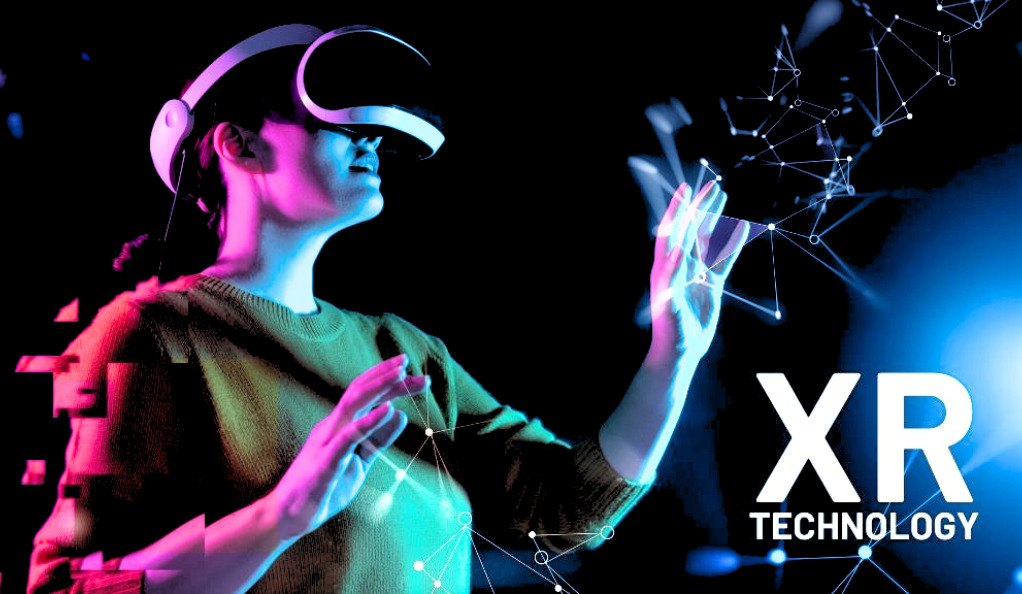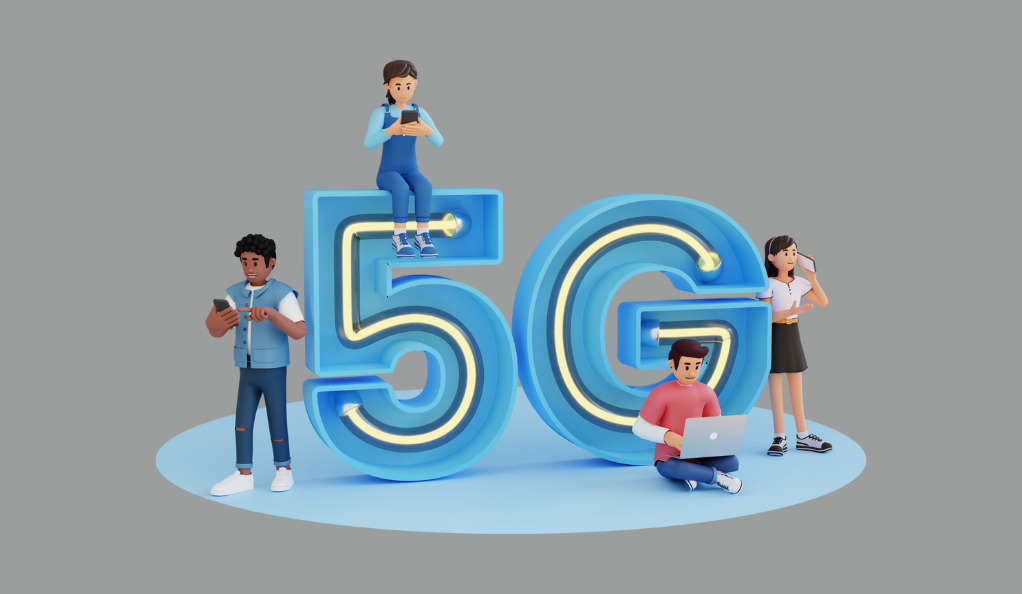Extended Reality (XR) is an exciting and rapidly evolving domain that encompasses a range of technologies designed to merge the boundaries between the physical and digital worlds. As we delve into the world of XR, it’s essential to understand its components and how it has evolved from its predecessors, Virtual Reality (VR) and Augmented Reality (AR).
Definition and Overview
Extended Reality (XR): XR is an umbrella term that captures various forms of computer-altered reality, including Augmented Reality (AR), Virtual Reality (VR), and Mixed Reality (MR). It represents a continuum of technologies that bridge the gap between the fully real and the fully virtual.
- Virtual Reality (VR): A fully immersive digital experience where users are transported to a computer-generated environment, completely detached from the real world. Typically, users wear VR headsets that track their head movements and render 3D graphics to their eyes.
- Augmented Reality (AR): AR overlays digital content on the real world through devices like smartphones or AR glasses. It doesn’t replace the real world but rather enhances it with additional information or graphics.
- Mixed Reality (MR): MR is a blend of VR and AR. It anchors virtual objects to the real world, allowing users to interact with both physical and virtual items simultaneously.
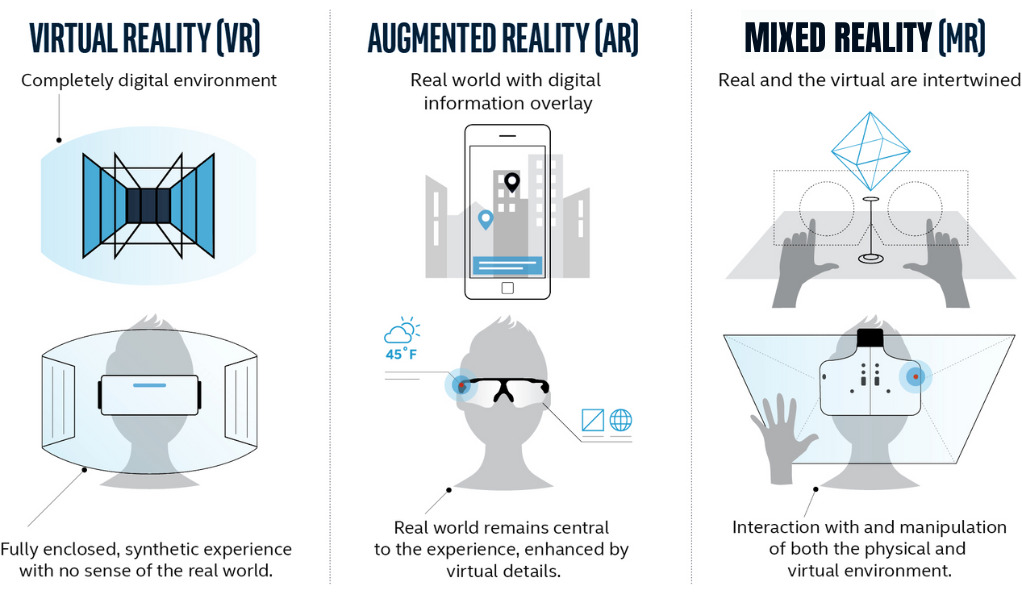
The Evolution from VR and AR to XR
The journey from VR and AR to XR is a tale of technological advancements and the quest to create more immersive and integrated digital experiences.
The Dawn of Virtual Reality (VR)
In the early stages, VR was a concept limited to science fiction. The 1960s saw the first VR headset, known as the “Sword of Damocles.” It was a massive apparatus, and the experience was rudimentary. Over the decades, with the advancement in computer graphics and hardware, VR became more sophisticated and accessible.
The Rise of Augmented Reality (AR)
AR’s concept began to gain traction in the late 20th century. One of the earliest instances of AR was the “First Down” line displayed during televised football games. The real breakthrough came with smartphones, which had the necessary sensors and cameras to overlay digital information on the real world effectively.
Merging Realities: The Birth of Mixed Reality (MR)
MR emerged as a hybrid of VR and AR, aiming to combine the best of both worlds. Devices like Microsoft’s HoloLens showcased the potential of MR, where virtual objects could be “pinned” to real-world locations and interacted with in real-time.
The Advent of Extended Reality (XR)
As the lines between VR, AR, and MR began to blur, there was a need for a collective term to encompass all these technologies, leading to the birth of XR. XR is not just a technology but a shift in how we perceive and interact with the digital world.
Comparison Table: VR vs. AR vs. MR vs. XR
| Aspect | Virtual Reality (VR) | Augmented Reality (AR) | Mixed Reality (MR) | Extended Reality (XR) |
|---|---|---|---|---|
| Environment | Fully Virtual | Real with digital overlays | Blend of real and virtual | Spectrum from fully real to fully virtual |
| Hardware | VR Headsets | Smartphones, AR glasses | MR headsets like HoloLens | All of the above |
| User Interaction | In a simulated space | In the real world with added digital elements | Interacts with both real and virtual objects | Varies based on the specific technology |
| Applications | Gaming, Training, Simulations | Navigation, Gaming, Information overlay | Design, Collaboration, Gaming | All applications of VR, AR, and MR |
The Components of XR: VR, AR, and MR
Virtual Reality (VR): Immersive Digital Experiences
Virtual Reality, commonly referred to as VR, offers users a fully immersive digital experience. When one dons a VR headset, they are transported into a computer-generated environment, completely detached from their physical surroundings. This environment can be as realistic as a simulation of our universe or as fantastical as a completely alien world. The primary goal of VR is to make the user feel as if they are genuinely “inside” this digital realm. This immersion is achieved through a combination of stereoscopic displays, head tracking, and sometimes even hand and body tracking. Popular applications of VR include video games, training simulations, and virtual tourism.
Augmented Reality (AR): Overlaying Digital Content on the Real World
Augmented Reality, or AR, seamlessly blends the digital and physical worlds. Unlike VR, which immerses users in a wholly digital environment, AR overlays digital content—be it images, information, or animations—onto the user’s view of the real world. This is typically achieved using cameras on devices like smartphones or specialized AR glasses. The digital content is rendered in real-time and can interact with real-world objects. For instance, pointing your smartphone at a historical monument might display information about its history. AR has a wide range of applications, from gaming and entertainment to more practical uses like navigation and education.
Mixed Reality (MR): The Blend of Real and Virtual Worlds
Mixed Reality, abbreviated as MR, can be thought of as the middle ground between VR and AR. It combines elements of both to create an environment where real-world and digital objects coexist and interact in real-time. MR goes beyond the static overlays of AR by anchoring virtual objects to real-world locations. This means that a user could see a virtual object, like a holographic chair, and walk around it, viewing it from different angles as if it were a real object in their room. Devices like Microsoft’s HoloLens are pioneering this space, showcasing the potential of MR in fields like design, collaboration, and even remote assistance.
The “Digital Twin” Concept in XR
Understanding the Digital Twin World
The concept of a “Digital Twin” refers to a virtual representation or model of a physical entity or system. This digital counterpart mirrors its real-world object in real-time, capturing its current state, behaviors, and functions. The idea is to have an exact digital replica of something from the real world, be it a machine, a building, a city, or even a human body. By having this digital representation, stakeholders can monitor, analyze, and optimize the physical entity without having to interact with it directly. For instance, in the realm of manufacturing, a digital twin of a machine might provide insights into its performance, predict when maintenance is needed, or simulate how changes might impact its efficiency.
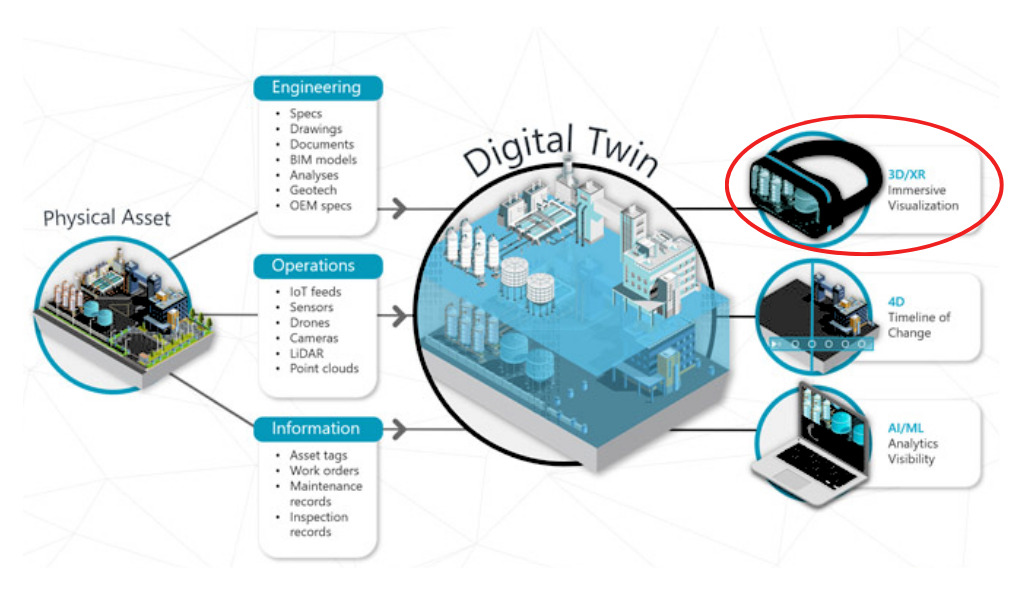
How XR Enables Interaction Between the Physical and Digital Twin Worlds
Extended Reality (XR) plays a pivotal role in bringing the concept of the digital twin to life. While the digital twin provides a data-rich virtual model of a physical entity, XR offers an immersive platform to visualize, interact with, and manipulate this model. Through AR, users can overlay the digital twin’s data onto the real-world entity, seeing real-time analytics and simulations directly on the physical object. With VR, stakeholders can dive deep into the digital twin’s environment, exploring its intricacies in a fully immersive setting. MR further bridges the gap, allowing for real-time interactions between the physical world and its digital counterpart. For example, an engineer could use MR to visualize the airflow around a digital twin of a car model, then make real-time adjustments to the physical model based on this data. In essence, XR acts as the interface between the physical and digital twin worlds, making the data actionable and the interactions intuitive.
Applications of Extended Reality (XR)
Extended Reality (XR) is revolutionizing various industries by offering immersive experiences that were previously unimaginable. Its ability to blend the digital and physical worlds has opened up a plethora of opportunities across different sectors. Let’s delve into some of the primary applications of XR:
Entertainment and Gaming
XR has made significant strides in the entertainment and gaming industry.
In the realm of gaming, Extended Reality (XR) offers a spectrum of immersive experiences. Virtual Reality (VR) plunges players into captivating digital universes, from epic battles with mythical dragons to deep-sea explorations, providing a firsthand gaming perspective. Augmented Reality (AR) games, exemplified by phenomena like Pokémon Go, superimpose digital components onto our actual environment, transforming everyday settings into interactive arenas. Meanwhile, Mixed Reality (MR) harmoniously melds the tangible and virtual, enabling gamers to engage with an intertwined reality, enriching the gaming landscape with dynamic interactivity.
Marketing and Advertising
Brands are leveraging XR to create more engaging and interactive marketing campaigns.
- AR allows consumers to “try before they buy.” For instance, furniture stores let customers visualize how a sofa would look in their living room through AR apps.
- VR can transport potential travelers to a virtual hotel room or a beach, giving them a taste of their potential vacation.
- MR can create interactive 3D advertisements that users can engage with in their physical space.
Real Estate Virtual Tours
XR is transforming the real estate industry by offering virtual property tours.
- Potential buyers or renters can take VR tours of properties from the comfort of their homes, exploring every nook and cranny without physically being there.
- AR apps can overlay information about local amenities, schools, or transport links onto a user’s view as they explore a neighborhood.
- MR can allow potential buyers to visualize their own furniture and decorations within a property.
Training and Education
Educational institutions and businesses are using XR for training and educational purposes.
In the medical field, Virtual Reality (VR) serves as a groundbreaking tool, allowing aspiring doctors to simulate surgical procedures, thereby minimizing the inherent risks of hands-on training. In educational settings, Augmented Reality (AR) transforms traditional classrooms by superimposing historical facts or scientific details on tangible objects, fostering a more engaging and interactive learning experience. Mixed Reality (MR) further elevates this by crafting situations where learners navigate and respond to both actual and virtual challenges, honing their analytical and problem-solving capabilities.
Maintenance and Remote Work
XR is proving invaluable for maintenance work and remote collaboration.
- Engineers can use AR to overlay schematics or instructions onto machinery, aiding in maintenance or repair tasks.
- VR can create a virtual office space, where remote teams can collaborate as if they were in the same room, discussing projects, and sharing digital resources.
- With MR, technicians can get real-time assistance from experts located elsewhere, with the expert seeing what the technician sees and guiding them through tasks.
Comparison Table: Applications of XR in Various Industries
| Industry | Virtual Reality (VR) | Augmented Reality (AR) | Mixed Reality (MR) |
|---|---|---|---|
| Gaming | Immersive game worlds | Game elements in real world | Interactive 3D games |
| Marketing | Virtual product demos | Product previews in real space | 3D interactive ads |
| Real Estate | Virtual property tours | Information overlays | Virtual home staging |
| Education | Simulation-based learning | Interactive class content | Real and virtual learning tools |
| Maintenance | Training simulations | Guided repair instructions | Real-time remote assistance |
Technological Advancements in Extended Reality (XR)
The realm of Extended Reality (XR) has witnessed rapid technological advancements in recent years, propelling it to the forefront of the tech industry. These innovations span across hardware, interaction methods, and software, each contributing to a richer, more immersive user experience. Let’s delve deeper into these advancements:
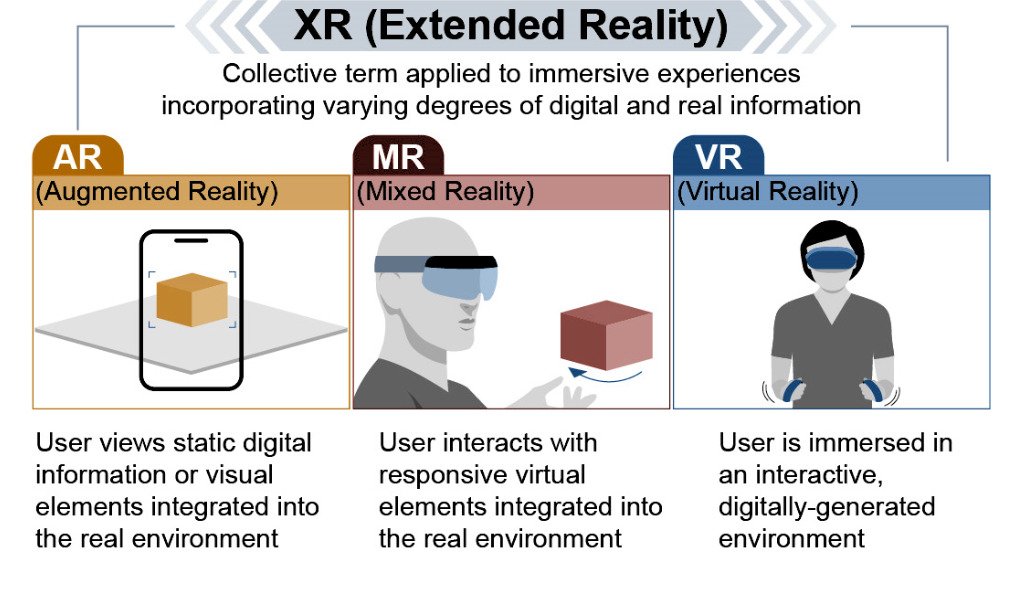
Display Technologies
The quality of the user’s experience in XR is significantly influenced by the display technology employed. Over the years, there have been remarkable improvements in this domain:
- Head-mounted displays (HMDs): These are wearable devices that provide users with immersive visual and auditory experiences. Modern HMDs come equipped with high-resolution screens, wider fields of view, and reduced latency, ensuring a seamless and realistic XR experience.
- Smart glasses: Unlike the bulkier HMDs, smart glasses are lightweight and resemble regular eyeglasses. They overlay digital information onto the user’s real-world view, making them ideal for AR applications. Companies like Google, with its Google Glass, and Apple are at the forefront of this technology.
Interaction Methods
Interaction methods define how users engage with the digital content in XR. The more intuitive and natural these methods are, the more immersive the experience:
- Pose tracking: This technology detects the position and orientation of the user’s body, translating it into the virtual environment. It allows users to move naturally in the digital space, enhancing immersion.
- Eye tracking: By monitoring where the user is looking, eye tracking enables more realistic and dynamic interactions in the virtual world. It can be used for tasks like selecting objects, navigating menus, or even for rendering optimizations.
- Finger tracking: This captures the movements of the user’s fingers, allowing for intricate interactions with virtual objects. It’s especially useful in MR and VR scenarios where hand gestures can control and manipulate the digital environment.
Software Advancements
The software is the backbone of XR, determining the quality, realism, and responsiveness of the virtual environment:
- Image-based rendering: This technique uses real-world images to generate virtual environments. It captures the lighting, texture, and depth of real scenes, making the virtual world look incredibly lifelike.
- Foveated rendering: A cutting-edge optimization technique, foveated rendering focuses on rendering the area where the user is looking in high resolution while reducing the quality of the peripheral vision. This not only improves performance but also reduces the computational load.
Challenges and Future Prospects of Extended Reality (XR)
While Extended Reality (XR) offers a plethora of opportunities, it also presents its own set of challenges. However, with these challenges come the prospects of future advancements and the potential to reshape our digital interactions. Let’s explore these challenges and the promising horizon of XR:
Challenges in XR
Overcoming VR Sickness and User Discomfort: One of the primary challenges faced by VR users is the phenomenon of VR sickness. Similar to motion sickness, it’s caused by a disconnect between what the user sees in the virtual environment and what their body feels. Symptoms can include dizziness, nausea, and fatigue. Additionally, prolonged use of XR devices can lead to user discomfort, stemming from factors like the weight of the headset, eye strain, or even psychological factors.
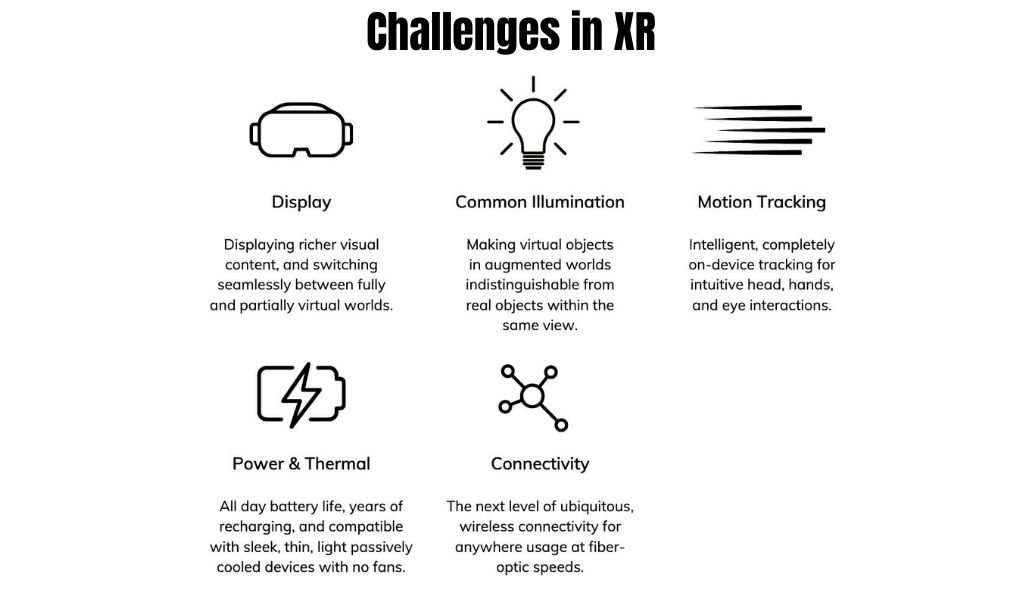
The Potential of XR in the Metaverse
Integration into the Metaverse: The concept of the metaverse, a collective virtual shared space created by converging virtually enhanced physical reality and interactive digital spaces, is gaining traction. XR stands at the forefront of realizing this concept. With XR technologies, users can seamlessly interact, work, socialize, and create within these expansive digital universes. The potential applications range from virtual concerts and events to collaborative workspaces and digital economies.
Future Research and Developments in XR
Pioneering the Next Wave: The field of XR is ripe for innovation. As technology continues to advance, we can anticipate improvements in realism, interactivity, and accessibility. Research is underway to reduce latency further, enhance haptic feedback, and create more lightweight and comfortable wearables. Additionally, the integration of AI with XR can lead to more personalized and adaptive virtual experiences. The fusion of brain-computer interfaces with XR is another frontier, potentially allowing users to control and navigate virtual spaces using just their thoughts.
Conclusion
The realm of Extended Reality (XR) stands as a testament to human ingenuity and our relentless pursuit to bridge the gap between the tangible and the virtual. While challenges persist, they are but stepping stones towards a future where our digital and physical experiences intertwine seamlessly. As we continue to innovate and push the boundaries of what’s possible, we are not just shaping technology; we are sculpting the very fabric of our shared experiences. In this digital renaissance, XR emerges not merely as a tool but as a transformative force, heralding a new era of interaction, immersion, and imagination.

